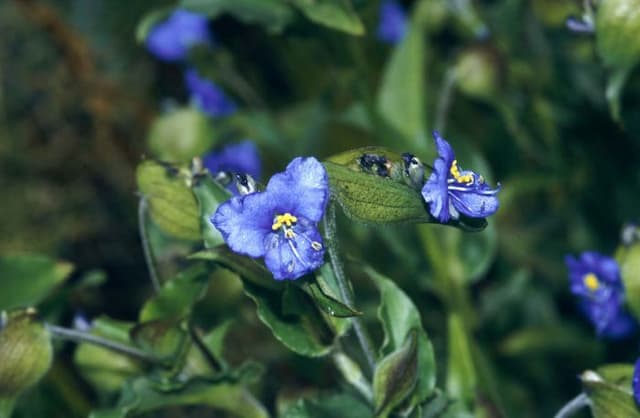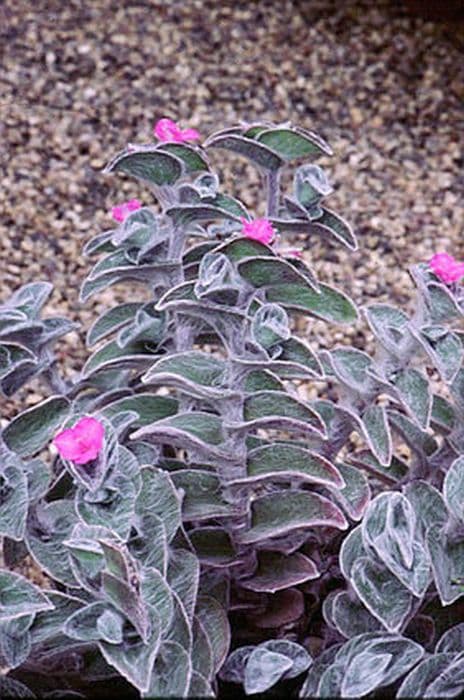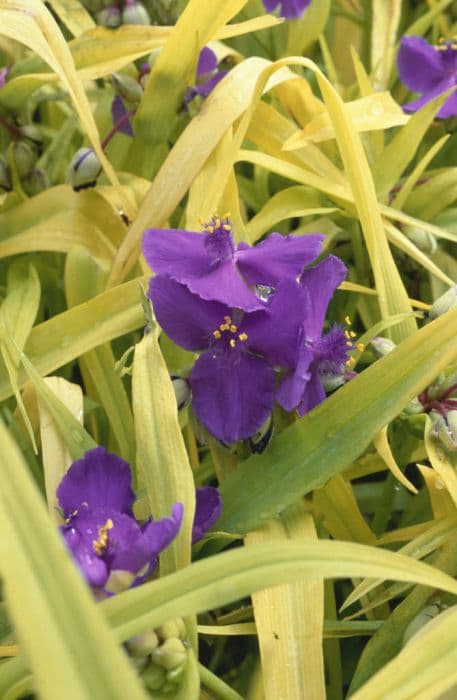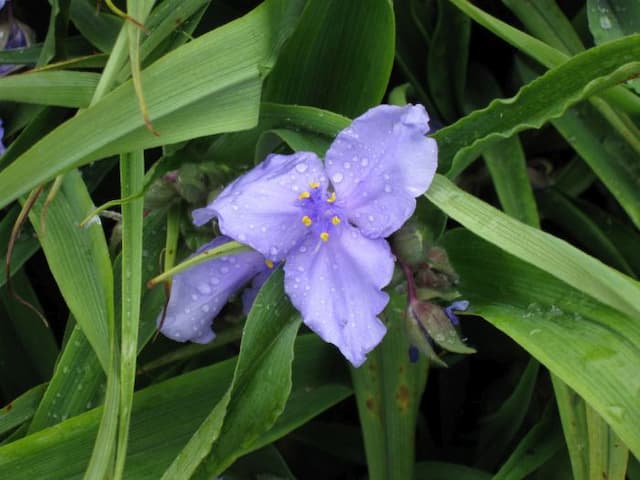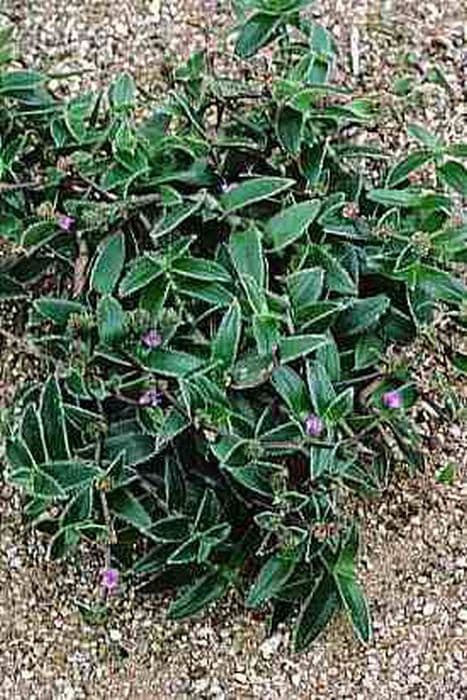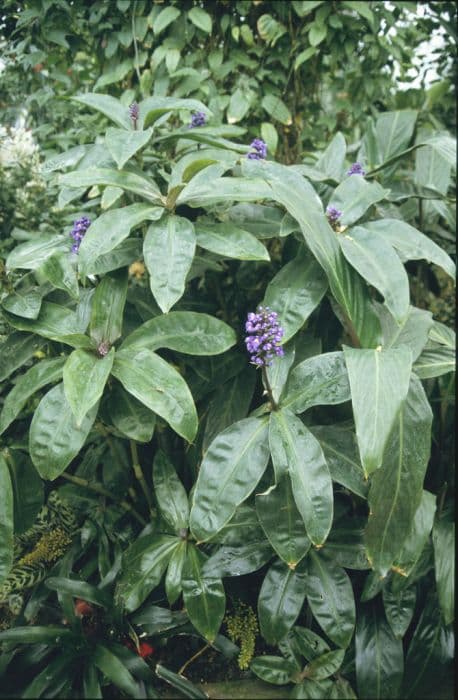Inch plant Tradescantia zebrina



ABOUT
Tradescantia zebrina, also known as Wandering jew or Inch plant, is a perennial herbaceous plant that is native to Mexico and Central America. The leaves of Tradescantia zebrina are typically glossy green and have a distinctive metallic silver or purple stripe running down the center of the leaf, giving it the common name of "zebrina" or "wandering jew."
The leaves are typically 2-4 inches long and 1-2 inches wide. The stems are typically trailing, growing up to 12 inches long and often rooting at the nodes. The plant produces small, three-petaled, pink or purple flowers, but are not very showy.
Tradescantia zebrina is a popular houseplant, known for its low maintenance, and ability to thrive in a wide range of conditions. It is tolerant of low light levels, and can be grown in a variety of potting soils. It is also known for its ability to propagate easily, making it a great choice for those who want to create a full, lush hanging basket.
About this plant
 Names
NamesFamily
Commelinaceae
Synonyms
Wandering Jew, Spiderwort, Wandering sailor, Silver inch plant, Inchplant, Speedy Henry, Zebrina pendula, Wandering dude
Common names
Tradescantia tricolor, Tradescantia zebrina pendula, Tradescantia pendula, Tradescantia pendula, Zebrina pendula, Zebrina pendula var. quadrifolia
 Toxicity
ToxicityTo humans
Tradescantia zebrina is considered to be non-toxic to humans when ingested or touched. However, it's important to note that the leaves and flowers of the plant contain small amounts of calcium oxalate crystals, which can cause skin irritation and oral pain if ingested.
Additionally, the flowers and leaves can cause skin irritation for people with sensitive skin.To pets
Tradescantia zebrina is considered to be mildly toxic to animals when ingested.
Consuming any part of the plant can cause oral pain, excessive drooling, vomiting and difficulty swallowing.
If you have pets in your home, it is recommended to keep this plant out of reach of them.
 Characteristics
CharacteristicsLife cycle
Perennials
Foliage type
Evergreen
Color of leaves
Multicolor
Flower color
Pink, purple
Height
Up to 12 inches
Spread
Up to 12 inches
Plant type
Herb
Hardiness zones
10
Native area
Eastern Mexico
Benefits
 General Benefits
General BenefitsTradescantia zebrina is a relatively low-maintenance plant that is easy to care for. It can tolerate a wide range of temperatures and humidity levels, and it does not require a lot of watering or fertilizing.
Tradescantia zebrina has attractive glossy green leaves with a distinctive metallic silver or purple stripe running down the center of the leaf, making it an attractive plant for any room.
The stems of Tradescantia zebrina are typically trailing, growing up to 12 inches long and often rooting at the nodes which makes it a great addition to a hanging basket.
Tradescantia zebrina is known for its ability to propagate easily, making it a great choice for those who want to create a full, lush hanging basket. Medical Properties
Medical PropertiesTradescantia zebrina is a species of spiderwort that has some medicinal properties.
It is known to have anti-inflammatory, antimicrobial, and antioxidant properties. Its leaves is be used to treat wounds, cuts, and burns, as well as skin infections. Its sap can be used topically to treat skin problems such as psoriasis and eczema.
It is also believed to have antifungal and antiviral properties and can be used to treat ailments such as colds and flu.
Additionally, it can be used to reduce the symptoms of asthma, allergies, and other respiratory disorders.
The use of this plant without the permission and consultation of a professional is not recommended and may be dangerous. Seek professional advice before using this plant. Air-purifying Qualities
Air-purifying QualitiesThe Tradescantia zebrina is known for its ability to remove toxins from the air, including formaldehyde, benzene, and trichloroethylene. This makes it a great choice for indoor spaces where air quality is a concern.
 Other Uses
Other UsesDue to its trailing habit, Tradescantia zebrina is often used in hanging baskets where its leaves and stems will trail down;
Due to its tolerance to low light, Tradescantia zebrina is often used as a terrarium plant, where it can thrive in the enclosed, humid environment;
In outdoor settings, it can be used as a groundcover in shady, moist areas;
The leaves of Tradescantia zebrina can be used as a natural dye, producing a range of colors from yellow to green and even blue, depending on the mordanting agent used and the pH of the dye bath.
Interesting Facts
 Feng Shui
Feng ShuiIn feng shui, Tradescantia zebrina is often used to bring a sense of tranquility and balance to a space.
It is believed to have the ability to purify the air and promote positive energy flow, making it a great choice for bedrooms and meditation rooms. Plant Symbolism
Plant SymbolismTradescantia zebrina is not known to have any specific symbolic meanings. It is often associated with its ability to purify the air and promote positive energy flow.
 Water
WaterTradescantia zebrina prefers to be kept consistently moist, but not waterlogged.
Water when the top inch of soil is dry to the touch, but avoid letting the soil dry out completely. It is recommended to water about once or twice a week, depending on the humidity and temperature of your home. Light
LightTradescantia zebrina can tolerate low light conditions, but it prefers medium to bright, indirect light.
It will do well in a room with a North or East facing window.
Avoid direct sunlight, which can cause leaf burn. Temperature
TemperatureThe Tradescantia prefers warm climates, where temperatures do not usually drop below 40ºF. It grows perfectly indoors, but if placed outdoors, care must be taken during the coldest nights. If temperatures often drop below 40ºF, it should be brought indoors.
Also, it can tolerate temperatures up to 95-99ºF as long as it does not receive direct sunlight, as this can burn its leaves. Pruning
PruningTradescantia zebrina can be pruned at any time, but it's best to do it during the spring or summer. Prune the plant back to the desired size and shape, and remove any yellow or dying leaves. Pinching the tips of the plant will encourage bushier growth.
 Cleaning
CleaningAs needed
 Soil
SoilTradescantia zebrina prefers well-draining, moist soil with a slightly acidic to neutral pH of 6.0-7.5.
A good quality, commercial potting soil that is well-draining with added perlite or sand to improve drainage will work well. Repotting
RepottingTradescantia zebrina should be repotted every 1-2 years, or when it outgrows its current pot. Repotting should be done in the spring, before new growth begins.
 Humidity & Misting
Humidity & MistingTradescantia zebrina prefers moderate to high humidity levels, ideally between 40-60%.
You can increase humidity around the plant by grouping it with other plants, using a humidifier or placing the pot on a tray of damp pebbles. Suitable locations
Suitable locationsIndoor
All year round
Outdoor
The plant is tropical and should only be grown outdoors in a warm and humid climate.
To grow Tradescantia zebrina outdoors, choose a spot with bright, indirect light and a soil that is well-draining. Keep the temperature between 60-75°F and avoid frost.
Water the plant when the top inch of soil is dry to the touch and fertilize every 4-6 weeks during the growing season.
Clean the leaves regularly. Keep in mind that it's not cold hardy, so should be protected from frost.Hardiness zone
11 - 12 USDA
 Life cycle
Life cycleThe plant begins its life cycle as a seed, which germinates and grows into a seedling. As it matures, it will develop a more robust stem and leaves, and will begin to produce flowers. The flowers of Tradescantia zebrina are typically small and pink or purple in color, and are produced in clusters at the end of the stem.
The plant will continue to grow and produce leaves and flowers throughout the growing season, and will enter a dormant period during the winter months.
In the spring, it will emerge from dormancy and begin the cycle anew. With proper care, Tradescantia zebrina can live for several years. Propogation
PropogationPropogation time
Spring - early summer
By STEM CUTTINGS:
One of the most popular and easiest ways to propagate Tradescantia zebrina is by taking stem cuttings. Cut a stem about 4-6 inches long, remove the lower leaves and place it in a glass of water or moist soil. New roots will form in about 2-4 weeks, after which you can plant it in a pot with well-draining potting soil.
By LEAF CUTTINGS:
You can also propagate Tradescantia zebrina by taking leaf cuttings. Take a leaf and place it in a glass of water, or place it in a damp soil. The leaf will begin to form roots and new plants will grow from the base of the leaf.
By DIVISION:
Tradescantia zebrina can also be propagated by division. Carefully dig up the plant and gently separate the roots into different sections, making sure each section has a good amount of roots and leaves. Replant each section in a separate pot with well-draining potting soil.
 Pests
PestsSpider mite, Mealybug, Aphid
 Diseases
DiseasesRoot Rot, Powdery mildew, Leaf spot
